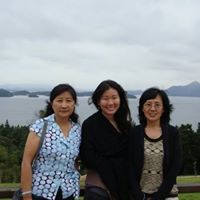Shu Jian Jiang
age ~52
from San Jose, CA
- Also known as:
-
- Shu J Jiang
- Shu N Jiang
- Shun Jiang
- Shun Giang
- Phone and address:
- 3429 Glenprosen Ct, San Jose, CA 95148
Shu Jiang Phones & Addresses
- 3429 Glenprosen Ct, San Jose, CA 95148
- Dublin, CA
- Milpitas, CA
- Temple Terrace, FL
Name / Title
Company / Classification
Phones & Addresses
3292 BRATER AVE, LLC
3232 BRATER AVE, LLC
Resumes

Developer
view sourceWork:
Sap 2008 - 2010
Developer
Developer

Shu Jiang
view source
Shu Jiang
view source
Shu Jiang
view source
Shu Jiang
view source
Shu Jiang
view sourceLocation:
United States

Shu Jiang Portland, OR
view sourceWork:
North Carolina State University (NCSU), NC
Raleigh, NC
Nov 2009 to Jul 2012
Research Assistant Chemistry Department
Stanford, CA
Jun 2011 to Jul 2011
Visit Scholar nanostructure and nanotechnology, Institute of Chemistry, Chinese
Jul 2008 to May 2009
Research Assistant Beijing Normal University (BNU)
Mar 2007 to May 2008
Research Assistant
Raleigh, NC
Nov 2009 to Jul 2012
Research Assistant Chemistry Department
Stanford, CA
Jun 2011 to Jul 2011
Visit Scholar nanostructure and nanotechnology, Institute of Chemistry, Chinese
Jul 2008 to May 2009
Research Assistant Beijing Normal University (BNU)
Mar 2007 to May 2008
Research Assistant
Education:
North Carolina State University
2009 to 2012
Master in Chemistry Beijing Normal University
Sep 2005 to Jun 2009
Bachelor of Science in Chemistry
2009 to 2012
Master in Chemistry Beijing Normal University
Sep 2005 to Jun 2009
Bachelor of Science in Chemistry
Skills:
UV/vis, FTIR, Resonance Raman, MS, FPLC, HPLC; PCR, DNA purification, cell culture, transformation, mutagenesis, protein expressing and purification, SDS-PAGE, protein crystallography, SELEX; Microsoft Office, Origin Lab, Matlab, MD simulation, DFT calculation
Us Patents
-
Hybrid Performance Critic For Planning Module's Parameter Tuning In Autonomous Driving Vehicles
view source -
US Patent:20230053243, Feb 16, 2023
-
Filed:Aug 11, 2021
-
Appl. No.:17/444877
-
Inventors:- Sunnyvale CA, US
QI LUO - Sunnyvale CA, US
SHU JIANG - Sunnyvale CA, US
YU CAO - Sunnyvale CA, US
YU WANG - Sunnyvale CA, US
JIAMING TAO - Sunnyvale CA, US
KECHENG XU - Sunnyvale CA, US
HONGYI SUN - Sunnyvale CA, US -
International Classification:B60W 60/00
B60W 30/095
B60W 40/02
G06N 20/00 -
Abstract:One or more outputs from a planning module of an ADV are received. Data of a driving environment of the ADV is received. A performance of the planning module is evaluated by determining a score of the performance of the planning module based on the data of the driving environment and the one or more outputs from the planning module. Whether the one or more outputs from the planning module violates at least one of a set of safety rules is determined. The score is determined being larger than a predetermined threshold in response to determining that the one or more outputs from the planning module violate at least one of the set of safety rules. Otherwise, the score is determined based on a machine learning model. The planning module is modified by tuning a set of parameters of the planning module based on the score.
-
Extended Model Reference Adaptive Control Algorithm For The Vehicle Actuation Time-Latency
view source -
US Patent:20210323564, Oct 21, 2021
-
Filed:Apr 21, 2020
-
Appl. No.:16/854718
-
Inventors:- Sunnyvale CA, US
Qi LUO - Sunnyvale CA, US
Shu JIANG - Sunnyvale CA, US
Jinghao MIAO - Sunnyvale CA, US
Jiangtao HU - Sunnyvale CA, US
Jingao WANG - Sunnyvale CA, US
Jinyun ZHOU - Sunnyvale CA, US
Jiaxuan XU - Sunnyvale CA, US -
International Classification:B60W 50/04
B60W 60/00
B60W 10/18
B60W 10/20
B60W 50/06
G05D 1/02 -
Abstract:Systems and methods are disclosed for reducing second order dynamics delays in a control subsystem (e.g. throttle, braking, or steering) in an autonomous driving vehicle (ADV) and increasing control system bandwidth by accounting for time-latency in a control subsystem actuation system. A control input is received from an ADV's autonomous driving system. The control input is translated into a control command of the control subsystem of the ADV. A reference actuation output and a predicted actuation output are generated corresponding to a by-wire (“real”) actuation action for the control subsystem. A control error is determined between the reference actuation action and the by-wire actuation action. A predicted control error is determined between the predicted actuation action and the between the by-wire actuation action. Adaptive gains are determined and applied to the by-wire actuation action to generate a second by-wire actuation action.
-
Bayesian Global Optimization-Based Parameter Tuning For Vehicle Motion Controllers
view source -
US Patent:20210323578, Oct 21, 2021
-
Filed:Apr 15, 2020
-
Appl. No.:16/849817
-
Inventors:- Sunnyvale CA, US
QI LUO - Sunnyvale CA, US
JIAXUAN XU - Sunnyvale CA, US
JINYUN ZHOU - Sunnyvale CA, US
SHU JIANG - Sunnyvale CA, US
JIAMING TAO - Sunnyvale CA, US
YU CAO - Sunnyvale CA, US
WEI-MAN LIN - Sunnyvale CA, US
KECHENG XU - Sunnyvale CA, US
JINGHAO MIAO - Sunnyvale CA, US
JIANGTAO HU - Sunnyvale CA, US -
International Classification:B60W 60/00
G06N 20/00
G06F 17/18
B60W 50/04 -
Abstract:In one embodiment, a computer-implemented method for optimizing a controller of an autonomous driving vehicle (ADV) includes obtaining several samples, each sample having a set of parameters, iteratively performing, until a predetermined condition is satisfied: determining, for each sample, a score according to a configuration of the controller based on the set of parameters of the sample, applying a machine learning model to the samples and corresponding scores to determine a mean function and a variance function, producing a new sample as a minimum of a function of the mean function and the variance function with respect to an input space of the set of parameters, adding the new sample to the several samples, and outputting the new sample as an optimal sample, where parameters of the optimal sample are utilized to configure the controller to autonomously drive the ADV.
-
Differential Dynamic Programming (Ddp) Based Planning Architecture For Autonomous Driving Vehicles
view source -
US Patent:20210318683, Oct 14, 2021
-
Filed:Apr 8, 2020
-
Appl. No.:16/843545
-
Inventors:- Sunnyvale CA, US
JINYUN ZHOU - Sunnyvale CA, US
SHU JIANG - Sunnyvale CA, US
JIAMING TAO - Sunnyvale CA, US
YU WANG - Sunnyvale CA, US
JIAXUAN XU - Sunnyvale CA, US
KECHENG XU - Sunnyvale CA, US
JINGHAO MIAO - Sunnyvale CA, US
JIANGTAO HU - Sunnyvale CA, US -
International Classification:G05D 1/02
G01C 21/34
G05D 1/00 -
Abstract:In one embodiment, method performed by an autonomous driving vehicle (ADV) that determines, within a driving space, a plurality of routes from a current location of the ADV to a desired location. The method determines, for each route of the plurality of routes, an objective function to control the ADV autonomously along the route and, for each of the objective functions, performs Differential Dynamic Programming (DDP) optimization in view of a set of constraints to produce a path trajectory. The method determines whether at least one of the path trajectories satisfies each constraint and, in response to a path trajectory satisfying each of the constraints, selects the path trajectory for navigating the ADV from the current location to the desired location.
-
Group And Combine Obstacles For Autonomous Driving Vehicles
view source -
US Patent:20210300427, Sep 30, 2021
-
Filed:Mar 25, 2020
-
Appl. No.:16/830090
-
Inventors:- Sunnyvale CA, US
QI LUO - Sunnyvale CA, US
JINYUN ZHOU - Sunnyvale CA, US
KECHENG XU - Sunnyvale CA, US
YU WANG - Sunnyvale CA, US
SHU JIANG - Sunnyvale CA, US
JIANGTAO HU - Sunnyvale CA, US
JINGHAO MIAO - Sunnyvale CA, US -
International Classification:B60W 60/00
G05D 1/00
G05D 1/02
B60W 30/09 -
Abstract:In one embodiment, a plurality of obstacles is sensed in an environment of an automated driving vehicle (ADV). One or more representations are formed to represent corresponding groupings of the plurality of obstacles. A vehicle route is determined in view of the one or more representations, rather than each and every one of the obstacles individually.
-
Static-State Curvature Error Compensation Control Logic For Autonomous Driving Vehicles
view source -
US Patent:20210291855, Sep 23, 2021
-
Filed:Mar 23, 2020
-
Appl. No.:16/826707
-
Inventors:- Sunnyvale CA, US
Qi Luo - Sunnyvale CA, US
Jinyun Zhou - Sunnyvale CA, US
Shu Jiang - Sunnyvale CA, US
Jiaxuan Xu - Sunnyvale CA, US
Jinghao Miao - Sunnyvale CA, US
Jiangtao Hu - Sunnyvale CA, US -
International Classification:B60W 60/00
B60W 30/18
B60W 10/20
B60W 10/04
G05D 1/02 -
Abstract:In one embodiment, static-state curvature error compensation control logic for autonomous driving vehicles (ADV) receives planning and control data associated with the ADV, including a planned steering angle and a planned speed. A steering command is generated based on a current steering angle and the planned steering angle of the ADV. A throttle command is generated based on the planned speed in view of a current speed of the ADV. A curvature error is calculated based on a difference between the current steering angle and the planned steering angle. The steering command is issued to the ADV while withholding the throttle command, in response to determining that the curvature error is greater than a predetermined curvature threshold, such that the steering angle of the ADV is adjusted in view of the planned steering angle without acceleration.
-
Nested Scenarios In Planning For Autonomous Driving Vehicles
view source -
US Patent:20210291863, Sep 23, 2021
-
Filed:Mar 23, 2020
-
Appl. No.:16/827510
-
Inventors:- Sunnyvale CA, US
QI LUO - Sunnyvale CA, US
JINYUN ZHOU - Sunnyvale CA, US
KECHENG XU - Sunnyvale CA, US
YU WANG - Sunnyvale CA, US
SHU JIANG - Sunnyvale CA, US
JIANGTAO HU - Sunnyvale CA, US
JINGHAO MIAO - Sunnyvale CA, US -
International Classification:B60W 60/00
G05D 1/02
B60W 40/04
G05D 1/00 -
Abstract:In one embodiment, an ADV is routed by executing a first driving scenario that is active. The first driving scenario is one of a plurality of driving scenario types, each driving scenario type being associated with one or more stages to be executed while a corresponding driving scenario type is active. Based on an environmental condition around the ADV, a second driving scenario is set as active. The ADV is routed by executing the second driving scenario. When the second driving scenario exits, execution of the first driving scenario resumes at the one or more stages of the first driving scenario that remains to be executed.
-
Open Space Path Planning Using Inverse Reinforcement Learning
view source -
US Patent:20210294340, Sep 23, 2021
-
Filed:Mar 23, 2020
-
Appl. No.:16/827452
-
Inventors:- Sunnyvale CA, US
Qi Luo - Sunnyvale CA, US
Shu Jiang - Sunnyvale CA, US
Jiaming Tao - Sunnyvale CA, US
Yu Wang - Sunnyvale CA, US
JiaXuan Xu - Sunnyvale CA, US
KeCheng Xu - Sunnyvale CA, US
Jinghao Miao - Sunnyvale CA, US
Jiangtao Hu - Sunnyvale CA, US -
International Classification:G05D 1/02
G05D 1/00 -
Abstract:In one embodiment, a method determines a route from a first location of an autonomous driving vehicle (ADV) to a second location within an open space, the first location being a current location of the ADV. The method determines an objective function based on the route, the objective function having a set of costs for maneuvering the ADV from the first location to the second location. The method determines environmental conditions of the open space and uses the environmental conditions to determine a set of weights, each weight to be applied to a corresponding cost of the objective function. The method optimizes the objective function in view of one or more constraints, such that an output of the objective function reaches minimum while the one or more constraints are satisfied and generates a path trajectory with the optimized objective function to control the ADV autonomously according to the path trajectory.

Shu Jiang
view source
Shu Jiang
view source
Shu Jiang
view source
Shu Y. Jiang
view source
Shu Jiang
view source
Shu Jiang
view source
Zhi Shu Jiang
view source
Jiang Zhi Shu
view sourceYoutube
Myspace

Shu Jiang
view sourceGoogleplus

Shu Jiang
Education:
Georgia Institute of Technology - Robotics

Shu Jiang

Shu Jiang

Shu Jiang

Shu Jiang

Shu Jiang

Shu Jiang

Shu Jiang
Get Report for Shu Jian Jiang from San Jose, CA, age ~52





